By Steve Kramer

GOLAN HEIGHTS, Israel — With four friends, over the Shavuot holiday we got away to the Golan Heights for a long weekend. The weather was absolutely perfect: vivid blue skies, fluffy clouds, temperature just about 80 degrees F, and the clearest air I’ve ever seen in that area.
On the way up North, we stopped for breakfast at Kibbutz Beit Hashita in the Lower Galilee. Dating back to the the early 1930s, the kibbutz was established on land purchased from Arab landlords who rented it to fellahin (peasants). After legal complications were dealt with, the kibbutz developed its agricultural assets: cotton, wheat, melons, olives and citrus fruits, as well as a dairy barn, chickens and a fish farm. More land was added from Arab villages abandoned during the War of Independence, and in the 1960s a pickling factory was established (later sold to food giant Osem) which produces and markets pickles, olives and pickled vegetables under the popular brand name Beit Hashita.
The kibbutz has a roadside petrol station, cafe, and a smaller cafe specializing in hummus, pita, and salads (a hummusiya). We ate in the lovely cafe, adjacent to the golden kibbutz fields. The food, coffee, and atmosphere were great.
Because it was Shavuot and we were sitting right next to the fields, the conversation turned to the holiday, which has a strong agricultural component and is one of the three pilgrimage holidays to go up to Jerusalem (the others are Succot and Pessah). We discussed the bikurim, the first fruits of the harvest, which made this seasonal festival a nationalistic, rather than religious, holiday during the days of the Zionist pioneers, most of whom worked the land in rustic, harsh agricultural settlements.
We also discussed the two other aspects of the holiday: the giving of the Torah at Mount Sinai and the Book of Ruth. About 4,000 years ago, Moses led the Children of Israel into the desert during the Exodus from Egypt. At Mt. Sinai, Moses ascended the mountain and returned after 40 days with the tablets of the 10 Commandments and the Torah. Because the Israelites had become frightened by his absence, they had convinced Aharon, the High Priest, to construct a golden calf for them to worship. Aghast at this idolatry, Moses dashed the tablets upon the ground, but later returned to the summit where the Lord gave Moses another set of tablets – and gave the Israelites another chance to be the “chosen” people who would present the Lord’s laws to the pagans. (Read the Book of Exodus, or watch Charlton Heston in The Ten Commandments.)
Ruth’s story is often brought up in contemporary Israel, because she is the first convert to Judaism mentioned in the Torah. “The book is about a Moabite woman who, after her husband dies, follows her Israelite mother-in-law, Naomi, into the [Land of the] Jewish people with the famous words ‘Whither you go, I will go, wherever you lodge, I will lodge, your people will be my people, and your God will be my God.’ She asserts the right of the poor to glean the leftovers of the barley harvest, breaks the normal rules of behavior to sexually entice her kinsman Boaz, is redeemed by him for marriage, and becomes the ancestor [great grandmother] of King David.” (myjewishlearning.com)
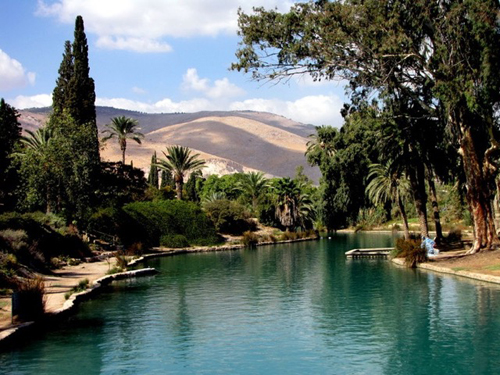
Satiated, we continued our journey to our first destination, Gan Hashlosha aka Sachne, a national park which some believe to be the site of the Garden of Eden. “The pools at Gan Hashlosha are fed by a natural spring which rises within the park feeding water at a constant 82 degrees F year-round. The spring flows into natural pools which have been somewhat widened by man to create a popular swimming destination year-round. The pools flow through the park via the Amal Stream, across waterfalls and natural whirlpools. The pools themselves draw swarms of people who come for a day of relaxation amid the beautiful lush greenery.” (touristisrael.com)
We chose to do a water hike through the meandering river. For about an hour and a half we walked through the knee high to shoulder high water, swimming where necessary. The water was clear, the scenery beautiful, and there were several pipes to slide through near the end of the stream to add a touch of excitement.
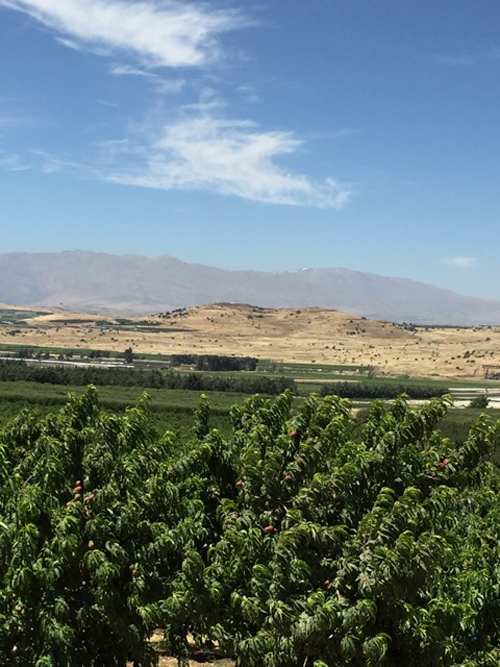
Afterwards, we drove up onto the Golan plateau, a small geographic area, albeit with large geo-political imprint. After stopping at one of the many orchards to buy sweet red cherries and enjoy the fantastic vista overlooking Syria, we drove to Buq’ata, a Druze village.
The Druze are Arabic-speaking citizens of Israel who serve in the Israel Defense Forces. Members of the community have attained high positions in Israeli politics and public service. They are not Muslims, but belong to a secret, esoteric sect which prohibits marrying outside of the faith.
The Golan Druze aren’t Israeli citizens, they’re Syrians. (Israel claimed the Golan Heights from Syria in the defensive 1967 Six Day War.) Until recently, most of the Golan Druze remained loyal to Syria, but in the last several years sentiments have changed. It’s likely that the Golan Druze, 20,000 out of a total of 120,000 Druze in Israel, would currently resist returning sovereignty of the Golan Heights to Syria, which in any event has ceased to exist as a nation state.
After a hearty lunch at one of the restaurants in Buq’ata, we traveled back down towards Lake Kinneret, aka Sea of Galilee, to our bed and breakfast in the town of Had Ness, a small communal village founded in 1989. It has beautiful views of the Kinneret and many vacation homes and B&Bs. That evening we barbecued meat and chicken and enjoyed the relaxing atmosphere.
The next day we went rafting on the Jordan River. Although the hour and a half journey down the storied river isn’t really exciting, it’s still fun to paddle along, get turned backwards, bump into the bank and into other boats, while jumping off to push the boat when necessary. Actually, the most exciting part is the slide into the water to begin the journey. After touring some more of the Golan, we rested at our B&B and later went to the Brew Pub for dinner in the town of Katzrin, the largest Jewish community on the Golan Heights.
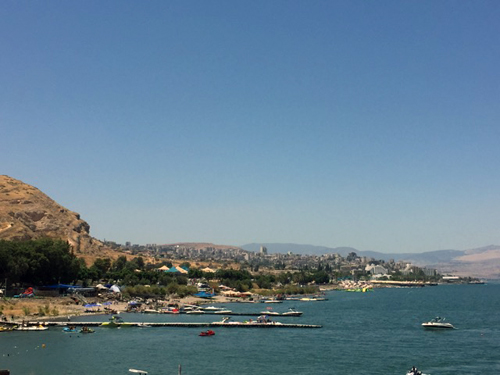
On the last day of our long weekend, we drove to the municipal spa in Tiberius. Hamat Tiberias National Park includes seventeen hot springs whose 140-degree F waters are infused with approximately 100 minerals with unique therapeutic qualities. The site’s healing capabilities have attracted people for at least 2,000 years. The waters from the springs feed the renowned Tiberias Springs Spa, which we enjoyed for several hours. The spa offers several thermo-mineral pools, luxurious body treatments and unique health treatments as well as the quiet atmosphere and the beautiful view of Lake Kineret. (Warning: music starts to blare at 12 noon.)
“The Kineret has attracted people for thousands of years, offering both a source of water and a livelihood. History has rendered both the Kineret area and Tiberias itself important to both Christians and Jews. Herod Antipas founded the city in 17-22 C.E., naming it after his patron, the Roman Emperor Tiberius. In the second through tenth centuries, Tiberias was the largest Jewish city in the Galilee, the Jewish people’s political and religious hub [at that time, Jews were forbidden to enter Jerusalem, which had been renamed Aelia Capitolina by the Romans], as well as the center of Jewish spiritual creativity.” (goisrael.com)
On the way home from Tiberius, we ascended from below sea level to a beautiful area of rolling hills in the eastern lower Galilee with checkerboard fields of green and yellow, which reminded me of Lancaster County, Pennsylvania. We stopped for coffee and a Shavuot-customary dairy dessert in the sleepy, pastoral, and picturesque town of Kfar Tavor, established in 1901. Kfar Tavor was founded by 20 farming families from other agricultural communities in the Galilee. It was the second Jewish settlement to have an organized Jewish guard unit, and following its establishment, the Hashomer organization was founded in 1909 to train Jewish guards and prepare a Jewish security force.
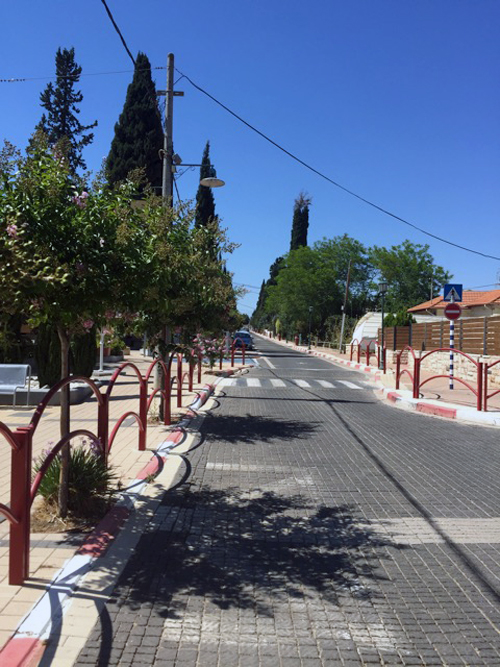
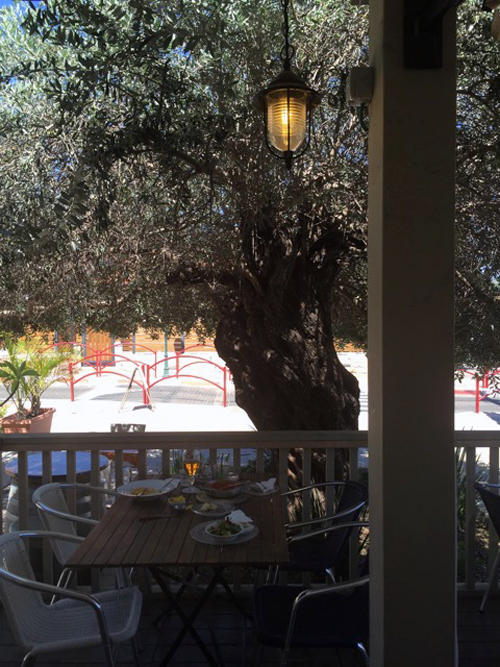
Kfar Tavor today has many attractive houses, a small industrial zone, and unique tourism sites, some of which are based on the local history. Kfar Tavor is just off the main road, offering easy access to the visitors in the area, coming or going to Lake Kineret or the Golan Heights.
Our small group had a fabulous weekend, full of history, vistas, (small) adventures, the holiday spirit, and great food and coffee! All of this is waiting for you, less than three hours from Tel Aviv.
*
Kramer is a freelance writer based in Alfe Menashe, Israel. He may be contacted via steve.kramer@sdjewishworld.com. Comments intended for publication in the space below MUST be accompanied by the letter writer’s first and last name and by his/ her city and state of residence (city and country for those outside the United States.)